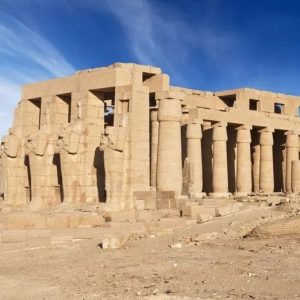Egypt Magic [1577]
The Ramesseum Temple in the ancient Egyptian language was known by the name “Khenmat Wast”, meaning “the one with Wast,” and it is a funerary temple west of the Nile in the desert region. “Wast” is the name of the city of Thebes / Luxor today, and it was called “Wast”, and it is the same name as the fourth region of the provinces of Al Wajh.
The tribal one was followed by the question What is the significance of this name?
And how can a funerary temple in the west of the Nile in a desert area be united with the West / Thebes, east of the Nile?
When the site was chosen for the construction of the temple, Ramses II decided to build his mortuary temple according to the kings of the eighteenth dynasty, and built the Ramesseum temple on the edge of the valley in the desert region, facing the Nile and the temples of the East Bank. This concept combines the pure funerary function of the temple and the place where the boat of Amun resting in
Temples of the East Bank (Luxor Temple) King Ramses dedicated the Ramesseum temple in honour of his father, Amun-Ra, despite being a funerary architecture. Still, it reached its climax like a true divine temple in the time of Ramses II. This type of temple had its local form for Amun, and it can be said that the Ramesseum follows the traditional planning of temples
a true divine temple in the time of Ramses II. This type of temple had its local form for Amun, and it can be said that the Ramesseum follows the traditional planning of temples
 a true divine temple in the time of Ramses II. This type of temple had its local form for Amun, and it can be said that the Ramesseum follows the traditional planning of temples
a true divine temple in the time of Ramses II. This type of temple had its local form for Amun, and it can be said that the Ramesseum follows the traditional planning of templesThe gods on the eastern mainland evoke the energy of the gods enhanced by daily worship. The originality of these millions of years old palaces lies above all in the connection of the heavenly world with the earthly world, and in the glorification of the royal function, in addition to choosing the special direction of the main axis of the temple (corresponding to the movement of the sun and facing the temple.
Luxor), which explains the irregularity of the entire monument and the trapezoidal shape of the temple, like the eastern and western walls of the temple, are not parallel to the outer walls.
The term for the appendices for this was called “Khenmat Wast”, meaning “the one with Wast” (Thebes / Luxor)

Comment (0)